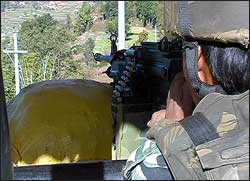 Two years after it was sucked into the war, the Royal Nepali Army has transformed itself from a largely decorative force into a battle-hardened military with modern weaponry.
Two years after it was sucked into the war, the Royal Nepali Army has transformed itself from a largely decorative force into a battle-hardened military with modern weaponry. The army has justified the induction of lethal new automatic weapons, artillery, transport equipment and even attack helicopters to fight the Maoist insurgency. It says the guerrillas are using increasingly sophisticated long-range weapons and have acquired AK-47s from underground suppliers in India.
Contrary to public perception, however, it isn't just the Americans who are the main suppliers of military hardware to the Royal Nepali Army, but the Indians. Belgium, Britain and even China are the other suppliers.
The army has already replaced 5,000 of its standard issue SLR rifles with American M-16s. Another 15,000 are expected soon under the US government's $12 million military aid to fight the insurgency that also includes night vision equipment, body armour and military training. The army is keen to replace the rest of its unreliable 30-year-old SLRs.
 In the past two years, India has increased its hardware assistance under the Infantry Small Arms System (INSAS) that includes 5.56 caliber rifles, mortars and machine guns. It has supplied 50 military trucks, ammunition and four light attack helicopters: two Cheetahs and two Lancers equipped with cannon and rocket pods that have already seen some action during flushing-out operations in the midwest.
In the past two years, India has increased its hardware assistance under the Infantry Small Arms System (INSAS) that includes 5.56 caliber rifles, mortars and machine guns. It has supplied 50 military trucks, ammunition and four light attack helicopters: two Cheetahs and two Lancers equipped with cannon and rocket pods that have already seen some action during flushing-out operations in the midwest. The Indian assistance is worth some Rs 5 billion, most of which was grant aid. "They are very willing to supply the arms under the INSAS provision and we are happy receiving most of them as grants," one official told us. "Such supplies are done directly by the North Bloc without too much involvement of the Indian bureaucracy."
 But in the field, it is the Belgian Minimi M249 belt-fed machine guns that soldiers are really excited about. "The Minimi is the best deterrence we have against Maoist attacks at present," one army source told us, citing its capacity to fire 1,000 rounds a minute upto a range of 1km. The Minimis replace earlier clip-ammunition guns that took time to reload and were not useful in Maoist human wave attacks. The army bought 5,500 Minimis from Belgium last year in a controversial E25 million deal that triggered a political crisis in Belgium with the resignation of the foreign minister.
But in the field, it is the Belgian Minimi M249 belt-fed machine guns that soldiers are really excited about. "The Minimi is the best deterrence we have against Maoist attacks at present," one army source told us, citing its capacity to fire 1,000 rounds a minute upto a range of 1km. The Minimis replace earlier clip-ammunition guns that took time to reload and were not useful in Maoist human wave attacks. The army bought 5,500 Minimis from Belgium last year in a controversial E25 million deal that triggered a political crisis in Belgium with the resignation of the foreign minister. A similar controversy has now erupted in Britain over the supply of military equipment to Nepal. Last year, Britain bought two Mi-17 transport helicopters for the Royal Nepali Army under its 'Global Conflict Prevention Pool'.
 However, the British government has come under fire from human rights activists for contravening its own arms exports guidelines not to supply military equipment to armies that flout human rights. A British embassy official in Kathmandu refuted this charge: "The UK has been supplying non-lethal equipment to the RNA that are not used directly to kill people." Britain is now said to be considering an army request for secondhand short-takeoff and landing transport planes.
However, the British government has come under fire from human rights activists for contravening its own arms exports guidelines not to supply military equipment to armies that flout human rights. A British embassy official in Kathmandu refuted this charge: "The UK has been supplying non-lethal equipment to the RNA that are not used directly to kill people." Britain is now said to be considering an army request for secondhand short-takeoff and landing transport planes. Having acquired anti-aircraft guns from China in the late 80s, the army has recently taken delivery of Chinese-made field commnication equipment. "Of course, the anti-aircraft guns are not for firing at planes, but they are ideal in mountainous terrain," one army source said.


